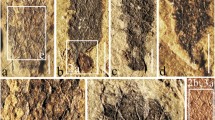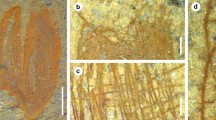Abstract
The chemical composition of sponge spicules was studied based on the debatable fossil early Cambrian sponge Lenica unica Gorjansky, 1977 from the Siberian Platform. The study has shown that the skeleton of this giant sponge is built of large monaxon megascleres that are a natural carbonate–silica–organic compound with a complicated chemical composition. The data we obtained confirm that the earliest early Cambrian sponges formed skeletal elements of a mixed carbonate–biosilica composition. The authors suggest that this skeleton composition was the initial for all spiculate sponges.



Similar content being viewed by others
REFERENCES
Bakhturov, S.F., Evtushenko, V.M., and Pereladov, V.S., Kuonamskaya bituminoznaya karbonatno-slantsevaya formatsiya (The Kuonamka Bituminous Carbonate–Shale Formation), Tr. Inst. Geol. Geofiz., Sib. Otd., Akad. Nauk SSSR, Novosibirsk: Nauka, 1988.
Zhuravlev, A.Yu., Early history of Metazoa: The view of a paleontologist, Zh. Obsh. Biol., 2014, vol. 75, no. 6, pp. 411–465.
Ivantsov, A.Yu., Zhuravlev, A.Yu., Krasilov, V.A., et al., Unique Sinsk locations of Early Cambrian organisms (Siberian Platform), Tr. Palentol. Inst. Ross. Akad. Nauk, 2005, vol. 284, pp. 1–143.
Arasuna, A., Kigawa, M., Fujii, S., et al., Structural characterization of the body frame and spicules of a glass sponge, Minerals, 2018, vol. 8, no. 3, pp. 88. https://doi.org/10.3390/min8030088
Archer, S.K, Dennison, G., Tryon, L., et al., Invertebrate settlement and diversity on a glass sponge reef, Can. Field-Nat., 2020, vol. 134, pp. 1–15.
Barthel, D., Tissue composition of sponges from the Weddell Sea, Antarctica: Not much meat on the bones, Mar. Ecol.: Prog. Ser., 1995, vol. 123, pp. 149−153.
Botting, J.P., Muir, L.A., Xiao, S., Li, X., and Lin, J.P., Evidence for spicule homology in calcareous and siliceous sponges: Biminerallic spicules in Lenica sp. from the Early Cambrian of South China, Lethaia, 2012, vol. 45, no. 4, pp. 463–475.
Chang, S., Zhang, L., Clausen, S., et al., Source of silica and silicification of the lowermost Cambrian Yanjiahe Formation in the Three Gorges area, South China, Palaeogeogr. Palaeoclimatol. Palaeoecol., 2020, vol. 548, pp. 109697. http://doi: https://doi.org/10.1016/j.palaeo.2020.109697.
Chu, J.W.F., Maldonado, M., Yahel, G., and Leys, S.P., Glass sponge reefs as a silicon sink, Mar. Ecol.: Prog. Ser., 2011, vol. 441, pp. 1–14.
Conway, K., Barrie, J., and Krautter, M., Geomorphology of unique reefs on the western Canadian shelf: Sponge reefs mapped by multibeam bathymetry, Geo-Mar. Lett., 2005, vol. 25, no. 4, pp. 205–213.
Ehrlich, H. et al., Insights into chemistry of biological materials: Newly discovered silica–aragonite–chitin biocomposites in demosponges, Chem. Mater., 2010, vol. 22, pp. 1462–1471.
Fürsich, F.T. and Pan, Y., Diagenesis of bivalves from Jurassic and Lower Cretaceous lacustrine deposits of northeastern China, Geol. Mag., 2016, vol. 153, pp. 17–37.
Gunasekaran, S., Anbalagan, G., and Pandi, S., Raman and infrared spectra of carbonates of calcite structure, J. Raman Spectrosc., 2006, vol. 37, no. 9, pp. 892–899.
Harvey, T.H.P., Carbonaceous preservation of Cambrian hexactinellid sponge spicules, Biol. Lett., 2010, vol. 6, no. 6, pp. 834–837.
Hodkiewicz, J., Characterizing carbon materials with Raman spectroscopy, Thermo Fisher Sci. Appl. Note 51901, 2010, pp. 1–5.
Ivantsov, A.Yu., Zhuravlev, A.Yu., Leguta, A.V., et al., Palaeoecology of the Early Cambrian Sinsk biota from the Siberian Platform, Palaeogeogr. Palaeoclimatol. Palaeoecol., 2005, vol. 220, nos. 1–2, pp. 69–88.
Karpenko, A.A. and Drozdov, A.L., Skeletons of glass sponges as a substrate for creating functional composite organosilicon material, J. Mater. Appl., 2019, vol. 8, pp. 20–27.
Krautter, M., Conway, K., Barrie, J.V., et al., Discovery of a “living dinosaur”: Globally unique modern hexactinellid sponge reefs off British Columbia, Canada, Facies, 2001, vol. 44, pp. 265–282.
Kruse, P.D. and Zhuravlev, A.Yu., Middle-Late Cambrian Rankenella-Girvanella reefs of the Mila Formation, northern Iran, Can. J. Earth Sci., 2008, vol. 45, pp. 619–639.
Leys, S.P., Wilson, K., Holeton, H.M., et al., Patterns of glass sponge (Porifera, Hexactinellida) distribution in coastal waters of British Columbia, Canada, Mar. Ecol.: Prog. Ser., 2004, vol. 283, pp. 133–149.
Parfenova, T.M., Korovnikov, I.V., Eder, V.G., et al., Organic geochemistry of the Lower Cambrian Sinyaya Formation (northern slope of the Aldan anteclise), Russ. Geol. Geophys., 2017, vol. 58, pp. 586–599.
Rigby, J.K., Sponges of the Burgess Shale (Middle Cambrian), British Columbia, Palaeontographica Canadiana, 1986, vol. 2, pp. 1–105.
Sandford, F., Physical and chemical analysis of the siliceous skeletons in six sponges of two groups (Demospongiae and Hexactinellida), Microsc. Res. Tech., 2003, vol. 62, pp. 336–355.
Systema Porifera: A Guide to the Classification of Sponges, Hooper, J.N.A. and van Soest, R.W.M., Eds., New York: Kluwer/Plenum, 2002.
Torsvik, T.H. and Cocks, L.R.M., New global palaeogeographical reconstructions for the Early Palaeozoic and their generation, Early Palaeozoic biogeography and palaeobiogeography, Geol. Soc. London Mem., 2013, vol. 38, no. 1, pp. 5–24.
Tréguer, P.J. and De La Rocha, C.L., The World Ocean silica cycle, Annu. Rev. Mar. Sci., 2013, vol. 5, pp. 477–501.
Whitney, F., Conway, K., Thomson, R., et al., Oceanographic habitat of sponge reefs on the Western Canadian Continental Shelf, Cont. Shelf Res., 2005, vol. 25, pp. 211–226.
Yuan, X. and Zheng, H., In situ Raman spectroscopic studies of FeS2 pyrite up to 675 K and 2100 MPa using a hydrothermal diamond anvil cell, Mineral. Mag., 2015, vol. 79, pp. 1–10.
Zhuravlev, A.Yu. and Wood, R., Eve of biomineralization: controls on skeletal mineralogy, Geology, 2008, vol. 36, pp. 923–926.
Zhuravlev, A.Yu. and Wood, R., Dynamic and synchronous changes in metazoan body size during the Cambrian Explosion, Sci. Rep., 2020, vol. 10, pp. 6784. https://doi.org/10.1038/s41598-020-63774-2
Author information
Authors and Affiliations
Corresponding author
Ethics declarations
Conflict of interests. The authors declare that they have no conflict of interest.
Statement on the welfare of animals. This article does not describe any research using humans and animals as objects.
Additional information
Translated by I. Barsegova
Rights and permissions
About this article
Cite this article
Drozdov, A.L., Zhuravlev, A.Y., Karpenko, A.A. et al. The Morphology and Chemical Composition of Siliceous Spicules of the Early Cambrian Sponge Lenica unica Gorjansky, 1977. Russ J Mar Biol 48, 33–38 (2022). https://doi.org/10.1134/S1063074022010059
Received:
Revised:
Accepted:
Published:
Issue Date:
DOI: https://doi.org/10.1134/S1063074022010059




